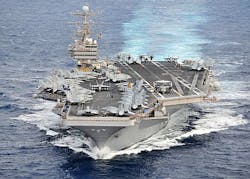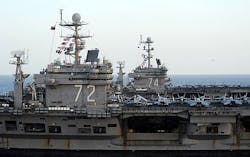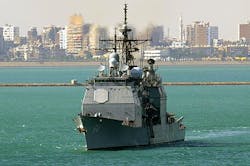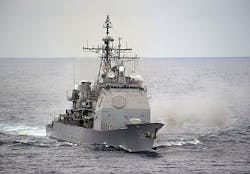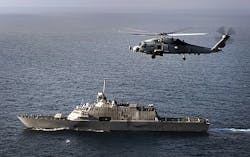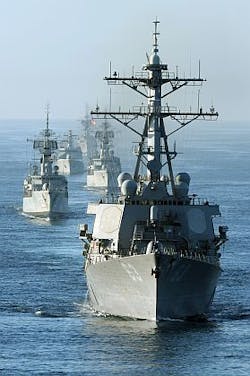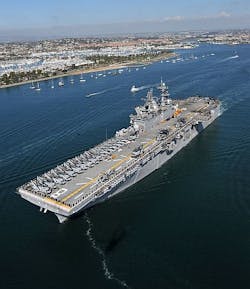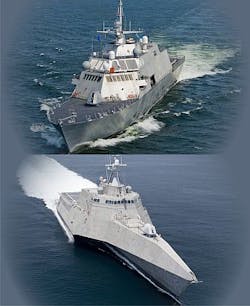Navy pushes innovations in shipboard electronics design despite facing tough budget cuts
SPECIAL REPORT, 16 Feb. 2012. The U.S. Navy is pressing forward with key shipboard electronics programs in surface warfare modernization initiatives even as its leaders face severe funding constraints for shipbuilding and systems acquisition that are likely to continue for the long term. Given the downward pressure on the U.S. Department of Defense (DOD) proposed budget for 2013, senior U.S. Navy and industry leaders are driving the need for decisive and game-changing ships, systems, and technologies for the fleet.
Progress continued in 2011 on the Navy’s major new shipbuilding initiatives with a rush of late-year actions. In October, Marinette Marine Shipbuilding in Marinette, Wis., laid the keel for the littoral combat ship USS Milwaukee (LCS 5), the third LCS to be built by the industry team of Lockheed Martin and Marinette Marine on a contract awarded in December 2010 with options for 10 ships; a similar contract was awarded to a second LCS team of General Dynamics Bath Ironworks in Bath, Me., and shipbuilder Austal USA in Mobile, Ala.
Navy officials say they hope to build 55 LCSs, a mix of the Lockheed Martin-Marinette traditional design (Freedom class) and the GD-Austal USA Independence-class three-hull trimarin. Both LCS designs will accommodate mine warfare, surface warfare, and anti-submarine warfare modules to accommodate the ship’s assigned mission.
Milwaukee should be delivered to the Navy in 2014. Also in October USS Fort Worth, the team’s second LCS, completed builder’s trials in Green Bay and Lake Michigan, and will be delivered next year.
Shipbuilding and strategy In late December, Austal USA won a $7.9 million contract for engineering services for the LCS program. The Navy awarded a modification to the General Dynamics-Austal LCS contract for construction of USS Jackson (LCS 6). Austal is completing work on its second LCS, USS Coronado (LCS 4) planned for delivery in May.
The team is under contract for a fourth ship, USS Montgomery (LCS 8). A total of 24 LCSs now are under contract under the December 2010 dual-block award.
The Lockheed Martin-Marinette LCS team includes Bollinger Shipyards Inc. in Lockport, La., Gibbs and Cox Inc. in Arlington, Va., Navantia in Madrid, Spain, and Blohm & Voss naval shipbuilders in Hamburg, Germany. GD-Austal team members are BAE Systems in London, Maritime Applied Physics Corp. in Baltimore, L-3 MAPPS in Montreal, Northrop Grumman Electronic Systems in Baltimore, and several General Dynamics businesses: Armament and Technical Products, Electric Boat, and General Dynamics Canada.
“We’ve stabilized shipbuilding—now we have to execute, by keeping costs down and delivering on time,” said Navy Vice Adm. Kevin McCoy in January, referring to LCS. McCoy is commanding officer of U.S. Naval Sea Systems Command in Washington.
McCoy cited progress on the San Antonio (LPD 17) class of amphibious assault ships, which had experienced extensive reliability problems caused, he said, by inadequate government oversight and unsatisfactory performance by the shipbuilder. He said the class has received “intense focus” in the past three years, with the newest ship, USS San Diego (LPD-22) put through extended acceptance trials. Two others, USS Mesa Verde (LPD 19) and USS Green Bay (LPD 20) have performed well on lengthy deployments, he added.
He pointed out that of the 313 ships the Navy expects to have in 2020, 75 percent of them are in the fleet today. “We have to maintain the ships,” he said. Currently, the Navy has 285 ships in service.
The Navy awarded General Dynamics Bath Iron Works a $1.8 billion contract in September to build the second and third Zumwalt-class (DDG 1000) destroyers, USS Michael Monsoor (DDG 1001) and as-yet unnamed DDG 1002. In November, the shipbuilder laid the keel for Zumwalt at its Bath, Me., shipyard. Zumwalt is scheduled for delivery in 2014, Monsoor in December 2015, and the third ship in February 2018.
Austal is building the Navy’s planned 10-ship class of joint high-speed vessels (JHSVs), which will transport personnel, vehicles, and equipment at speeds as fast as 35 knots. USS Spearhead, (JHSV 1) is set for builder’s trials; two ships are in the yard, and four more are under contract.
Overall, the Navy awarded contracts for 13 ships in 2011: three Arleigh Burke (DDG 51)-class destroyers; the two Zumwalts and two LCSs; two JSHVs, one San Antonio-class amphib; two mobile landing platforms, awarded to General Dynamics National Steel and Shipbuilding; and one oceanographic research ship (AGOR 27), to Dakota Creek Industries.
The Navy took delivery of two Burke-class destroyers, one Virginia-class attack submarine, one San Antonio-class ship, the USS San Diego, and two auxiliaries.
The Navy’s most long-term recent shipbuilding plan, released in February 2011, projects construction of 276 ships over 30 years, 2011-2040: 198 combatants and 78 auxiliaries. The Congressional Budget Office, in a March 2011 report, argues that “if the Navy receives the same amount of funding for ship construction over the next 30 years as in the past three decades … it will not be able to afford all the ships called for in the 2011 plan.”
The CBO study says that the Navy estimates that it will need $16 billion per year, or $476 billion over 30 years, to build the needed ships. The study adds though that the Navy’s estimate is solely for ship construction, and doesn’t include outfitting ships after construction or nuclear refueling for the aircraft carriers, which add about $2 billion per year, according to CBO.
Accounting for those and other post-delivery costs, CBO says, ship construction could cost roughly $21 billion per year or $569 billion for the 30-year timeframe, or about 18 percent higher than the Navy’s estimates.
Navy officials say that they’ve confronted the looming imbalance between funding and shipbuilding goals. In January, Wilmot Summerall, executive director for combatants in the Program Executive Office for Ships noted that the Navy now has 40 ships under contract, $14.5 billion in work on “should cost” budgets. The work provides a pipeline for the fleet for coming years, as budgets decline, he said.
The new U.S. defense strategy announced by President Obama on 6 Jan. suggests a continuing critical role for naval power. The President said that “ … we will of necessity rebalance toward the Asia-Pacific region. … We will emphasize our existing alliances, which provide a vital foundation for Asia-Pacific security. We will also expand our networks of cooperation with emerging partners throughout the Asia-Pacific … .”
A day earlier, Defense Secretary Leon Panetta said that “the most important thing, obviously is maintaining our naval presence in the Pacific, maintaining our military presence, and that the U.S. has a “common interest with China in dealing with the threats that exist in the Pacific.”
Ship systems
In July the Navy shut down the Program Executive Office for Littoral and Mine Warfare and stood up PEO Littoral Combat Ships, under Rear Adm. James Murdoch. The new PEO is responsible for six program offices that support the LCS program and oversee development of the LCS mission modules, with Northrop Grumman as prime contractor.
The surface package will consist of a 30-millimeter gun and a 57-millimeter naval gun provided by BAE Systems. The ASW module is expected to include the MH-60R helicopter controlling an airborne low-frequency sonar, as well as variable-depth sonar and the capability trail a multi-function towed array sonar, and other ASW systems.
The full-dress modernization of Ticonderoga-class (CG 47) cruisers and Burke-class destroyers, equipped with the Aegis combat system based on the SPY-1(v) phased-array radar, promises major gains in capability by introducing new technology and systems for battle group air-defense and ballistic missile defense (BMD). New combat system software will be compliant with the Navy’s Open Architecture initiative, represented by an Open Architecture Computing Environment (OACE), which mandates scalable, modular code based on commercial standards.
The first five “baseline 1” Tico-class ships have been taken out of service. Baseline 2 ships, CGs 52 through 58, have been fitted by longtime Aegis prime contractor Lockheed Martin MS2 with a new combat system software program called advanced capability build (ACB-08).
ACB-08 supports new computer hardware, display, and radar upgrades. The Mk-41 vertical launch system is modified to launch the Evolved Seasparrow missile for anti-air defense. Other upgrades include the Mk 15 Phalanx Block 1B close-in weapon system for terminal air defense, a shipboard advanced radar target identification system, the Common Link Data Management System, the Mk-116 (mod 7) undersea weapons tracking system, and the Cooperative Engagement Capability (CEC), for the cruisers not already equipped with it.
The baseline 3 (CGs 59 through 64) and baseline 4 ships (CGs 65 through 73) will get a new ACB-12 program, now under development at Lockheed Martin’s Moorestown, N.J., site, and planned for fielding this year. ACB-12 encompasses the ACB-08 system enhancements, plus BMD with upgrades to the transmitter of the Aegis phased-array radar, the SPY-1B, and a new multi-mission signal processor. The processor adds BMD for ships not already BMD-capable.
The baseline 3 and 4 ships also get an Aegis littoral processor, which improves radar discrimination in heavy surface clutter; the Naval integrated fire control-counter air (NIFC-CA); and the RIM-174 SM-6 extended range active air-defense missile. Other upgrades are the SPQ-9B anti-ship missile defense radar, and the Mk-45 .62 caliber gun system, which is controlled by a Mk-160 gun computing system. For undersea warfare, ACB-12 adds the SQQ-89A(v)15 undersea warfare system, which incorporates a multi-function towed array sonar.
In the past year the Navy and Lockheed have restructured the baseline designations of combat systems, reverting to a hierarchy that evolved from baseline 0 through 2 for the first four cruisers through baseline 7, which represented insertion of commercially developed processor technology.
In the new scheme, ACB-12 becomes baseline 9, which is further subdivided as 9A (cruisers 59 to 73); 9C (DDGs 51 to 78); 9D (new construction destroyers DDGs 113 to 116). Baseline 9E will support the Aegis Ashore radar for the new land-based missile defense system to be operational in Romania in August 2015 and in Poland in 2018.
The destroyer modernization will provide the same level of combat capability planned for the Sims and two following new-construction ships (DDGs 114 to 115): the Aegis SPY-1D radar transmitter upgrades; combat information center display improvements; and new navigation radar and identification friend/foe enhancements. For ship defense, they also receive new electronic warfare and torpedo defense capabilities.
Other upgrades are the SQQ-89A(v)15 with the multi-function towed array sonar, Evolved Seasparrow missile, Block 1B Phalanx, SM-6 air-defense missile, and NIFC-CA.
Sparta Inc. in Pasadena, Calif., is building power transmission assemblies for Lockheed Martin for the Aegis SPY-1D(v) and for the Aegis Ashore SPY variant. The company is under contract to Lockheed Martin for 3,700 radio and microwave assemblies, to be built at its Exeter, N.H., facility.
Navy and industry officials say that as the upgrades come online, the next step for surface combatants will be a decision to develop an air-missile defense radar (AMDR) that combines an X-band radar for precision tracking, horizon search, discrimination, and terminal target illumination, and an S-band radar for wide-area volume search, including ballistic-missile detection and tracking.
The Burke-class restart is expected to lead to introduction of a Flight III ship beginning with DDG-122, the first ship to be fitted out with the AMDR. The Navy will complete a two-year study of Flight III requirements this year. The new Burke will get other combat systems upgrades and a power architecture capable of meeting the huge power demands of the new combat system.
Lockheed Martin, Raytheon, and Northrop Grumman won contracts in 2009 for AMDR studies, to be completed this September. Northrop Grumman has done extensive work in electronically scanned S-band radars. In September 2011, Raytheon announced it had successfully demonstrated AMDR transmit-receive modules that incorporate new gallium nitride integrated circuit technology. Lockheed Martin also has demonstrated conceptual AMDR designs for the Navy.
Although Lockheed Martin has acted as the Navy’s combat systems engineering agent for Aegis support since 1995, the Navy is planning a competitive award for the role of Aegis CSEA for the next 10 years. In July of last year the Navy asked for bids on the CSEA work. Lockheed Martin MS2, Raytheon Integrated Defense Systems and Boeing’s Strategic Missile & Defense Systems submitted proposals in December, with the award expected this fall.
The Raytheon-built Mk1 and Mk 2 Ship Self-Defense System provide weapons and sensor control aboard aircraft carriers and big-deck amphibs. Late last year the company delivered the 30th and 31st Mk 2 systems for LHA-7, the newest America-class amphib and John P. Murtha (LPD-26).
The Mk 1 system is aboard USS Whidbey Island (LSD 41) and USS Harpers Ferry (LSD 49) class amphibs; the Mk 2, which is Open Architecture compliant, is aboard the Nimitz-class (CVN 68) carriers, the two newest Wasp-class ships USS Iwo Jima and USS Makin Island (LHDs 7 and 8), and San Antonio-class LPDs, and will go aboard USS America (LHA-6), now being built at Huntington Ingalls Industries, and USS Gerald R. Ford (CVN- 78), under construction at Huntington Ingalls Newport News Shipbuilding.
SSDS integrates ship air-defense weapons and sensors, including the SPS 48, SPS 49, and SPS 73 radars, the Mk 15 Phalanx close-in weapon system, NATO Seasparrow and Evolved Seasparrow air-defense missiles. Raytheon says that SSDS was developed aiming at an open processing architecture and has gone through several enhancements. The newest baseline incorporates elements of the total ship computing environment (TSCE), a network the company developed for DDG-1000 for control of all ship systems.
Raytheon also developed and builds the shipwide area network that integrates combat and machinery control systems aboard the San Antonios. The company provides the navigation data distribution system, integrated voice network, magnetic signature control system, and the SPS-73 radar for the class.
Further supporting fleet air defense, the Navy in December awarded a contract to Sechan Electronics of Litiz, Pa., for a new digital signal processor called the Sierra assembly for the CEC sensor network system.
CEC, built by Raytheon Netcentric Systems, is now in service or going aboard Ticos and Burkes, as well as Nimitz-class carriers, Wasp-class big-deck amphibious assault ships, and in an airborne variant, aboard the E-2D Hawkeye 2000 and Advanced Hawkeye surveillance aircraft.
The Sechan processor, which will conduct CEC core processing, employs a programmable Sierra II cryptographic element developed by Harris RF Communications in Rochester, N.Y. Sechan will deliver the processor to Raytheon for integration with the CEC processor unit, which controls the data distribution system communications component and the CEC directional antenna.
CEC enables CEC-equipped ships and aircraft to participate in a wide-area air-defense network. The processor fuses data obtained from radars and other sensors in a common target picture that is available in near-real time to all network participants. The system in separate variants is planned for the Marine Corps land-based Composite Tracking Network and the Army’s Joint Land Attack Cruise Missile Defense Elevated Netted Sensor System, or JLENS.
The Navy awarded Raytheon a contract in March 2011, modifying an earlier contract, for CEC production for the carrier USS Abraham Lincoln (CVN 72) and Gerald B. Ford (CVN 78), the first of Navy’s newest carrier class. Later, the company won a contract for airborne units for the E-2D Hawkeye, and in December received an order for CEC work for the Australian Navy’s new air-defense destroyer. The United Kingdom Royal Navy and the Canadian navy also will get CEC.
DDG-1000
The BAE Systems Weapon Systems business unit was set to deliver two gun mounts for the land-attack Advanced Gun System or AGS to the General Dynamics Bath shipyard for integration aboard the Zumwalt. The gun magazines already have been integrated with the hull in the modular construction method used to build the ship. The company received a $168 million Navy contract in October 2011 for production of the AGS for DDG-1002.
The guns will fire a maximum rate of 10 rounds per minute and could sustain that rate for the entire 300 rounds, BAE officials say. The gun and magazine systems will be automatic for loading and firing, with fire orders generated by the DDG-1000 TSCE.
The Weapons Systems business unit is the former United Defense, which BAE acquired in 2005. United Defense for years built the Navy’s Mk 45 five-inch shipboard deck gun, now modified as 62-caliber gun going aboard new-construction Burkes.
BAE Systems is teamed for development of the LRLAP round with Lockheed Martin Missile and Fire Control group, which is building test hardware.
In early November the Navy awarded General Dynamics a $14.3 million modification to an earlier contract, exercising options for DDG-1000-class logistics services. Raytheon’s Integrated Defense Systems group received a $20.8 modification to a previous award for engineering, production, and integration for the Zumwalt program for 2012, primarily for TSCE work.
Research and development
Several groundbreaking research and development initiatives are underway that apply new systems engineering concepts and technologies for surface-ship design. The Office of Naval Research has evaluated prototype components of an electronic warfare/information operations communications or EWIOC system and a submarine satellite communications multi-function mast. The components, ONR says, could be incorporated into a so-called Integrated Topside effort or INTOP, in ONR’s Innovative Naval Prototypes program.
The INPs are technology development efforts that offer promising warfighting payoffs. The INTOP effort aims to develop multi-function antenna apertures that could integrate electronic warfare, communications, and radar functions for surface ships and submarines. ONR officials say that the effort is developing a “scalable” family of apertures for multiple ship classes.
The program has evolved from an earlier ONR proof-of-concept called AMRFC, or advanced multifunction RF concept, that examined aperture designs and technologies developed by Lockheed Martin, Northrop Grumman, and Raytheon, that could be used interchangeably for radar, EW, and comm, thereby reducing the proliferation of shipboard antennas that increase electromagnetic interference, degrading performance and increasing ships’ radar signatures.
Two teams, one of Northrop Grumman Electronics Systems and ITT, and other of Raytheon and General Dynamics Advanced Information Systems (GDAIS) are developing EWIOC prototypes. Argon ST is working with both teams. BAE Systems, DRS Technologies, Colorado Engineering, Hypres Inc., and Southwest Research Institute are working on indefinite delivery/indefinite quantity contracts and would have to compete for INTOPS task orders.
The INTOP work dovetails with the Surface Electronic Warfare Improvement Program (SEWIP), an incremental effort to upgrade surface EW systems. GDAIS developed an early system, and Lockheed Martin is working on a block 2 SEWIP design.
In a related application of electric power, in January General Atomics, under contract to develop an electromagnetic aircraft launch system and advanced arresting gear (EMALS/AAG) for carriers, delivered the final unit of 12 energy storage system generator sets for installation aboard the new-construction flattop Gerald R. Ford.
The EMALS/AAG will replace the steam catapult system and hydraulic-powered arresting gear long used aboard carriers to launch aircraft. The system is expected to cost less to operate and maintain, improve catapult performance and reliability, and expand range of manned and unmanned aircraft that operate from carriers, according to the company.
Raytheon’s Integrated Defense Systems business won a $10 million award in October 2011 for research and development on design of power-load modules for an integrated power system and pulsed power loads for future surface combatants. The work entails development of power-load modules for use in “pulse-forming” networks for powering new systems such as railguns, lasers, and radars, as well as R&D on approaches to shipboard energy storage and on integrating the modules aboard ship.
Shipboard power
Together with the cruiser and destroyer modernization and other ship programs, the Navy is developing and testing new shipboard power and machinery designs aiming at the eventual goal of integrated power systems and an “all-electric” ship.
In a hybrid system, an electric motor is integrated with the ship’s propulsion system for use at low speeds, when gas turbine and diesel engines are less efficient.
The Wasp-class amphib Makin Island is fitted out with a hybrid system consisting of two General Electric LM2500+ gas turbine engines and two auxiliary diesel electric motors. Navy and industry officials have frequently cited its 2009 transit from Pascagoula, Miss., to San Diego, when the system reduced fuel costs by $2 million.
The General Atomics-DRS system consists of a permanent magnet motor, motor drive, and power converter and control electronics. At low speeds, the gas turbines provide power through a motor drive and a frequency converter to the motor, fitted to the reduction gear.
Following the Philadelphia testing, the prototype will go aboard the destroyer Truxton (DDG-103) for at-sea testing.
The planned fielding of the air missile defense radar for Flight III Burkes, with its high power requirements, make power generation a critical priority, Navy and industry officials say. General Electric, longtime builder of gas turbine engines for the Ticonderogas, Burkes, and amphibious ships, says that its GE38 engine, which will power the Marine Corps CH-53k heavy-lift helicopter, could be a candidate for the ship-service generator for the Flight III ship.
Edward J. Walsh is the naval systems columnist for U.S. Naval Institute Proceedings. A former Marine Corps communications-electronics officer and veteran defense journalist, he is the former senior editor for Sea Power magazine, where he reported on Navy weapon system and technology development, and is the founding editor and publisher of Naval Systems Update, a semi-monthly publication that covers Navy systems integration and program news.
